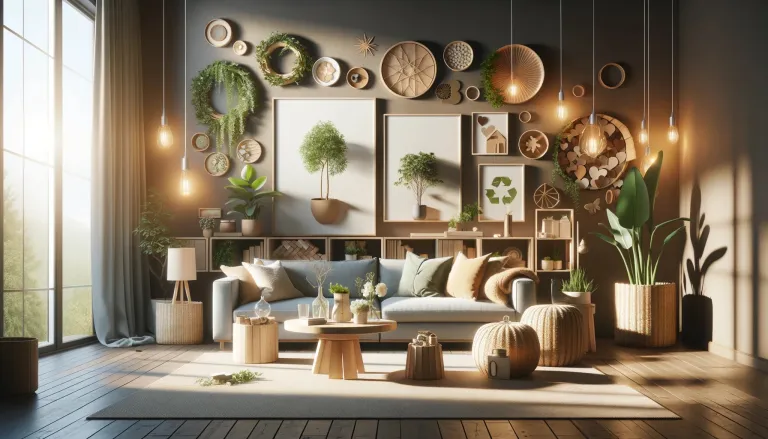In an age where climate consciousness has moved from a niche passion to a global movement, the modern home is becoming the frontline of sustainability. From the way we build and power our spaces to how we decorate, eat, and even clean, “green living” is no longer a buzzword—it’s a lifestyle evolution. The good news? …
Green Living: Sustainable Choices for the Modern Home

In an age where climate consciousness has moved from a niche passion to a global movement, the modern home is becoming the frontline of sustainability. From the way we build and power our spaces to how we decorate, eat, and even clean, “green living” is no longer a buzzword—it’s a lifestyle evolution. The good news? You don’t need to live off the grid or spend a fortune to make your home eco-friendly. A few intentional choices can drastically reduce your carbon footprint while improving your quality of life.
1. Building a Foundation for Sustainability
Sustainability starts at the ground level—literally. Eco-friendly construction materials such as reclaimed wood, bamboo, cork, and recycled metal have gained traction as alternatives to traditional materials. These not only reduce environmental strain but also add a unique aesthetic character to homes.
Energy-efficient insulation, double-glazed windows, and smart ventilation systems minimize energy loss, reducing both bills and emissions. Many new homeowners are even exploring passive house designs, which maximize natural light and heat regulation to reduce dependency on artificial systems.
For those not planning a full renovation, small upgrades like sealing air leaks, installing draft stoppers, or using weather-resistant paint can make a surprising difference in both comfort and energy savings.
2. Energy Efficiency: Powering the Future Home
The shift toward renewable energy is one of the most tangible steps toward sustainable living. Solar panels, once considered a luxury, have become more affordable and efficient. They not only reduce electricity costs but also increase property value and resilience against power outages.
Beyond generation, energy management is key. Smart home systems allow you to monitor and control energy usage through your smartphone. Motion-activated lighting, smart thermostats, and energy-efficient appliances like inverter-based air conditioners and refrigerators can cut consumption dramatically.
Simple habits matter too—switching to LED bulbs, unplugging unused devices, and using power strips can collectively reduce household energy waste. The aim is to make every watt count.
3. Water Wisdom: Conserving Every Drop
Water is the essence of life, yet it’s often taken for granted. Sustainable homes are designed to conserve this precious resource without compromising convenience.
Low-flow faucets and showerheads, dual-flush toilets, and efficient washing machines can reduce water usage by up to 50%. Installing rainwater harvesting systems helps recycle natural precipitation for gardening or outdoor cleaning.
For a more mindful approach, consider native or drought-resistant plants for landscaping. They require less watering, thrive in local conditions, and support regional biodiversity—a win for your yard and the planet.
4. The Sustainable Kitchen: Where Green Meets Gourmet
The kitchen is both the heart of the home and a major contributor to household waste. Sustainable cooking starts with mindful purchasing—buying local, seasonal produce not only supports farmers but also cuts down transportation emissions.
Embrace reusable containers, cloth napkins, and beeswax wraps instead of single-use plastics. Composting organic waste turns food scraps into nutrient-rich soil for your garden. Even energy-efficient cooking habits—like covering pots, using induction stoves, or cooking in batches—make a difference.
And let’s not forget: a plant-forward diet is one of the most impactful changes you can make. Reducing meat consumption even a few days a week significantly lowers your ecological footprint.
5. Eco-Chic Interiors: Style That Sustains
Sustainability doesn’t mean sacrificing style. Eco-chic interiors blend comfort, aesthetics, and responsibility. Choose furniture made from reclaimed or sustainably sourced materials. Upcycling—transforming old items into new treasures—is both creative and cost-effective.
When redecorating, look for low-VOC (volatile organic compounds) paints and natural fabrics like organic cotton, hemp, or linen. These are not only better for the planet but also improve indoor air quality.
Houseplants are another simple yet powerful addition. They purify the air, enhance mood, and bring a calming connection to nature indoors.
6. Cleaning Green: A Fresh Take on Freshness
Many conventional cleaning products contain harsh chemicals that harm waterways and indoor air quality. Green cleaning swaps these for natural alternatives like vinegar, baking soda, and lemon juice—effective, affordable, and safe.
Eco-certified cleaning brands are now widely available and often come in refillable or recyclable packaging. Consider making your own DIY cleaning solutions to minimize waste and save money. A clean home shouldn’t come at the cost of a polluted planet.
7. Waste Not, Want Not: The Art of Conscious Consumption
In a throwaway culture, one of the most powerful sustainable choices is simply to consume less. Adopting a minimalist approach—buying what you truly need and choosing durable, high-quality products—reduces waste and clutter.
Recycling and composting are essential, but the first step is refusing unnecessary items, like excessive packaging or trendy but disposable décor. Reuse and repurpose whenever possible. Remember the mantra: reduce, reuse, recycle, and rethink.
8. The Future of Sustainable Living
Sustainability isn’t just about individual choices—it’s a collective evolution. Governments are incentivizing renewable energy adoption, cities are promoting green infrastructure, and industries are embracing circular economies where products are designed to be reused or recycled.
Technology is helping bridge the gap between convenience and consciousness. From AI-powered energy management to eco-friendly home automation, the future of green living is smart, efficient, and beautifully simple.
Conclusion: The Greener Path Forward
A sustainable home isn’t built in a day—it’s shaped by the choices we make daily. Whether it’s switching to solar, composting leftovers, or simply turning off lights when you leave the room, every small effort contributes to a larger impact.
As our awareness deepens, green living is evolving from a personal preference into a shared responsibility. It’s not just about saving the planet—it’s about creating a healthier, more harmonious way of life. After all, sustainability begins at home, and every mindful choice brings us one step closer to a cleaner, greener world. 🌿




